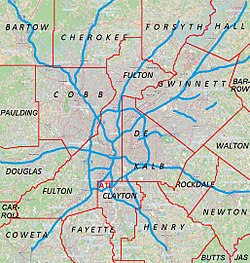Chattahoochee Hills
| Chattahoochee Hills, Georgia | |
|---|---|
| City | |

Chattahoochee Hills city hall
|
|
| Location of Chattahoochee Hills in Metro Atlanta | |
| Coordinates: 33°33′02″N 84°45′38″W / 33.55056°N 84.76056°W | |
| Country | United States |
| State | Georgia |
| County | Fulton County |
| Government | |
| • Mayor | Tom Reed |
| Area | |
| • Total | 51.0 sq mi (132.2 km2) |
| • Land | 50.2 sq mi (130.0 km2) |
| • Water | 0.9 sq mi (2.3 km2) |
| Population (2010) | |
| • Total | 2,378 |
| • Density | 47/sq mi (18.3/km2) |
| Time zone | EST |
| • Summer (DST) | EDT (UTC) |
| Website | www |
Chattahoochee Hills (formerly Chattahoochee Hill Country) is a city in southern Fulton County, Georgia, United States. As of the 2010 census, it had a population of 2,378 living in an area of just over 32,000 acres (130 km2). It is the incorporated part of a region called "Chattahoochee Hill Country", an area encompassing approximately 60,000 acres (240 km2) southwest of Atlanta, bordered on the northwest side by the Chattahoochee River. Unlike the rest of metro Atlanta, it is still relatively undeveloped, and most of its rural character remains unchanged. The majority of the wider area comprises the west-southwest part of southern Fulton, and smaller adjacent parts of southern Douglas, eastern Carroll, and northern Coweta counties.
The area that is now southwest Fulton was originally Campbell County, but it was merged into neighboring Fulton County on January 1, 1932.
Historically, much of the southwestern-most region of Fulton was considered to be a "town" called Rico, with other communities, including Goodes, Rivertown, County Line, and Pumpkintown, also within the new city's boundaries.
The idea of the area as "Chattahoochee Hills" is very recent, and grew out of attempts to incorporate all of Fulton County into cities following the 2005 incorporation of Sandy Springs, as well as more local efforts to take control of the local zoning in the multi-county Chattahoochee Hill Country area.
During the 2006 session, the Georgia General Assembly passed a law allowing the Fulton section of the area to incorporate as a city (the only type of municipality allowed in Georgia), the purpose being the municipalization of that county, and to allow local residents to have local control of zoning. This has included concentrating development in three planned villages, though the nearby city of Palmetto took one of them for itself, leaving a gerrymander-looking arm of it sticking northwest into the heart of the new city.
...
Wikipedia

